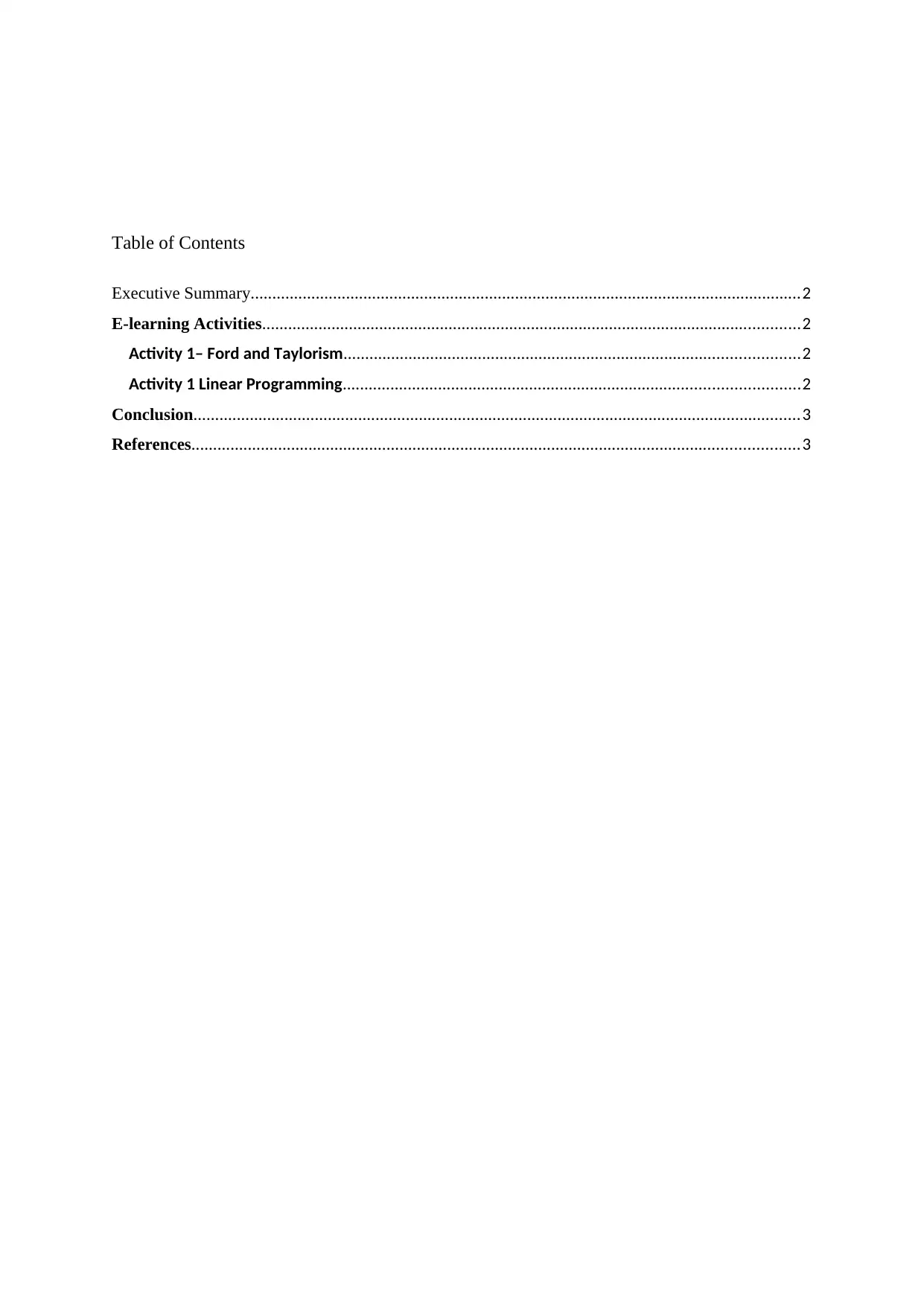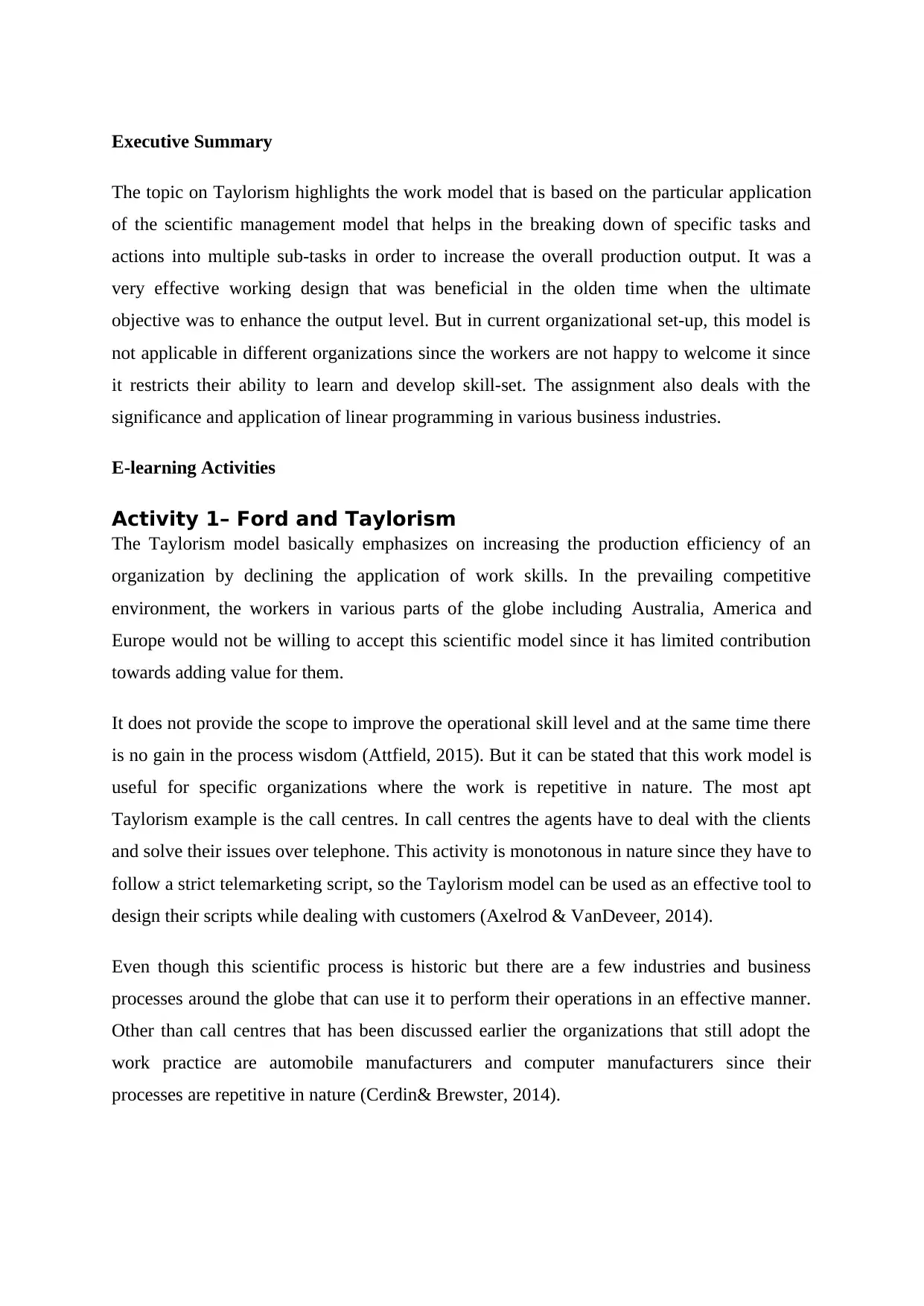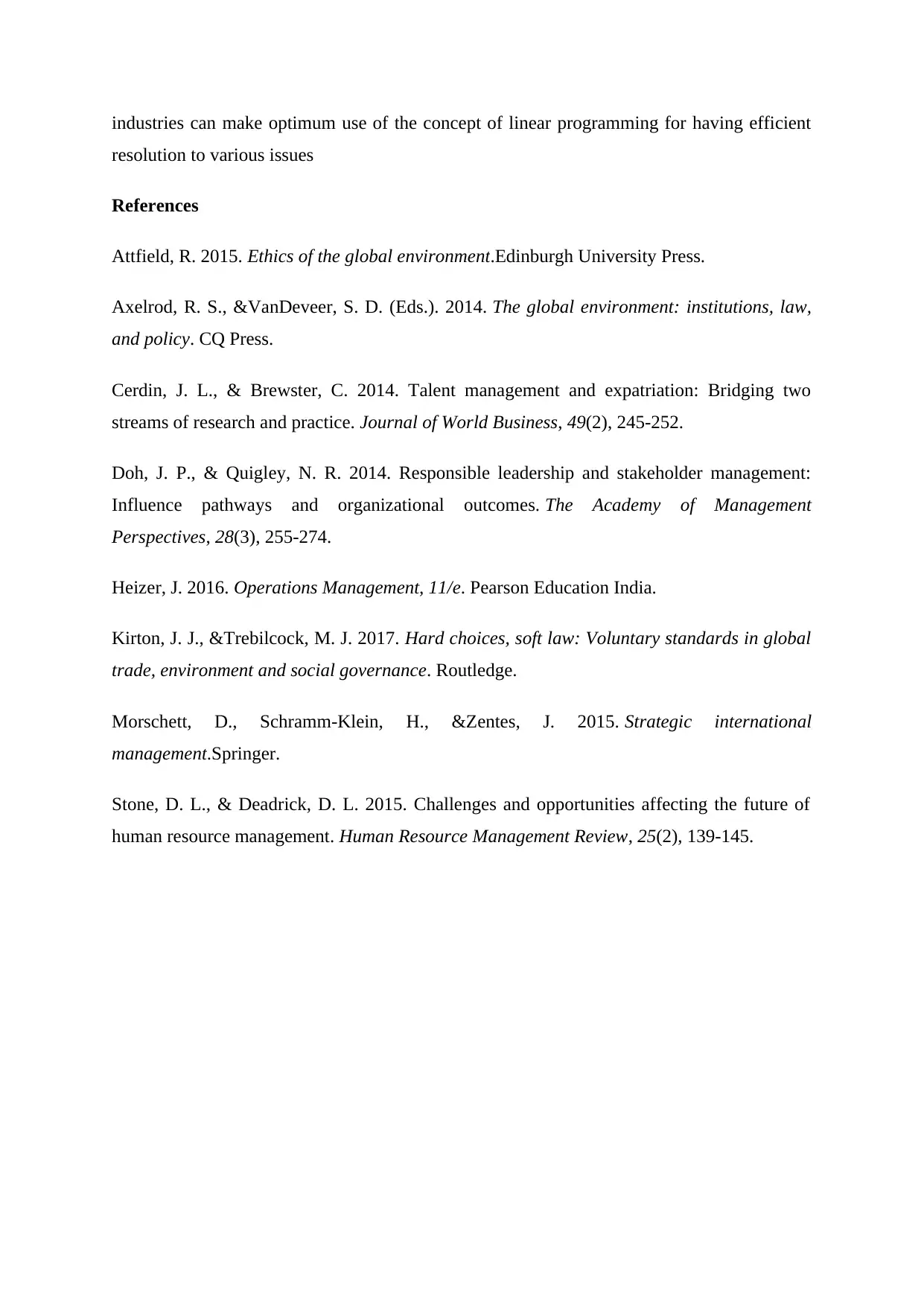Taylorism, Linear Programming: Business Application Analysis
VerifiedAdded on 2020/03/04
|4
|1068
|41
Homework Assignment
AI Summary
This assignment delves into two key concepts: Taylorism and linear programming, analyzing their relevance and application in business development. The assignment begins with an executive summary, highlighting Taylorism's focus on increasing production efficiency through task breakdown, and its limitations in contemporary organizational settings where worker skill development is valued. It then proceeds to examine the applications of linear programming in various business industries, emphasizing its usefulness in optimizing outcomes, particularly in resource allocation, inventory management, and decision-making processes. The assignment uses e-learning activities to illustrate these concepts, including the application of Taylorism in call centers and the practical use of linear programming in solving business problems, supported by references to relevant academic literature and industry practices. The conclusion reiterates the importance of both concepts for business efficiency and problem-solving.

Table of Contents
Executive Summary...............................................................................................................................2
E-learning Activities............................................................................................................................2
Activity 1– Ford and Taylorism.........................................................................................................2
Activity 1 Linear Programming.........................................................................................................2
Conclusion............................................................................................................................................3
References............................................................................................................................................3
Executive Summary...............................................................................................................................2
E-learning Activities............................................................................................................................2
Activity 1– Ford and Taylorism.........................................................................................................2
Activity 1 Linear Programming.........................................................................................................2
Conclusion............................................................................................................................................3
References............................................................................................................................................3
Paraphrase This Document
Need a fresh take? Get an instant paraphrase of this document with our AI Paraphraser

Executive Summary
The topic on Taylorism highlights the work model that is based on the particular application
of the scientific management model that helps in the breaking down of specific tasks and
actions into multiple sub-tasks in order to increase the overall production output. It was a
very effective working design that was beneficial in the olden time when the ultimate
objective was to enhance the output level. But in current organizational set-up, this model is
not applicable in different organizations since the workers are not happy to welcome it since
it restricts their ability to learn and develop skill-set. The assignment also deals with the
significance and application of linear programming in various business industries.
E-learning Activities
Activity 1– Ford and Taylorism
The Taylorism model basically emphasizes on increasing the production efficiency of an
organization by declining the application of work skills. In the prevailing competitive
environment, the workers in various parts of the globe including Australia, America and
Europe would not be willing to accept this scientific model since it has limited contribution
towards adding value for them.
It does not provide the scope to improve the operational skill level and at the same time there
is no gain in the process wisdom (Attfield, 2015). But it can be stated that this work model is
useful for specific organizations where the work is repetitive in nature. The most apt
Taylorism example is the call centres. In call centres the agents have to deal with the clients
and solve their issues over telephone. This activity is monotonous in nature since they have to
follow a strict telemarketing script, so the Taylorism model can be used as an effective tool to
design their scripts while dealing with customers (Axelrod & VanDeveer, 2014).
Even though this scientific process is historic but there are a few industries and business
processes around the globe that can use it to perform their operations in an effective manner.
Other than call centres that has been discussed earlier the organizations that still adopt the
work practice are automobile manufacturers and computer manufacturers since their
processes are repetitive in nature (Cerdin& Brewster, 2014).
The topic on Taylorism highlights the work model that is based on the particular application
of the scientific management model that helps in the breaking down of specific tasks and
actions into multiple sub-tasks in order to increase the overall production output. It was a
very effective working design that was beneficial in the olden time when the ultimate
objective was to enhance the output level. But in current organizational set-up, this model is
not applicable in different organizations since the workers are not happy to welcome it since
it restricts their ability to learn and develop skill-set. The assignment also deals with the
significance and application of linear programming in various business industries.
E-learning Activities
Activity 1– Ford and Taylorism
The Taylorism model basically emphasizes on increasing the production efficiency of an
organization by declining the application of work skills. In the prevailing competitive
environment, the workers in various parts of the globe including Australia, America and
Europe would not be willing to accept this scientific model since it has limited contribution
towards adding value for them.
It does not provide the scope to improve the operational skill level and at the same time there
is no gain in the process wisdom (Attfield, 2015). But it can be stated that this work model is
useful for specific organizations where the work is repetitive in nature. The most apt
Taylorism example is the call centres. In call centres the agents have to deal with the clients
and solve their issues over telephone. This activity is monotonous in nature since they have to
follow a strict telemarketing script, so the Taylorism model can be used as an effective tool to
design their scripts while dealing with customers (Axelrod & VanDeveer, 2014).
Even though this scientific process is historic but there are a few industries and business
processes around the globe that can use it to perform their operations in an effective manner.
Other than call centres that has been discussed earlier the organizations that still adopt the
work practice are automobile manufacturers and computer manufacturers since their
processes are repetitive in nature (Cerdin& Brewster, 2014).

Activity 1 Linear Programming
I could understand from the online tutorial video that linear programming can be used to
obtain the best and favourable outcomes like lowest cost and maximum profit in a model of
mathematics whose requirements are specified by the linear relationships existing between
them (Stone & Deadrick, 2015). I also understood that linear programming can be proved to
be very useful in different fields of industry. It finds best application and use in the business
and economics. This method of programming is also widely used in the resolving some
engineering problems. I could also understand that with the application of linear
programming, one can easily solve any kind of business problem (Doh& Quigley, 2014).
The limitations and conditions regarding the use and application of linear programming are
vital for individual or business organizations to follow. The key requirement of linear
programming is associated with the linear setup of every objective function and constraint
which is always not the case in real life scenario of business and industrial issues. For
applying linear programming into business organizations, a single objective has to be taken
into account which is very rare in the dynamic business environment of today’s world
(Heizer, 2016). The application of linear programming is very relevant in the optimal
allocation of resources like machines, materials, and manpower by a company. I could use
linear programming in enabling myself to resolve the issues related to recruitment, training,
selection and deployment of the human resources as these are very important aspects for me
being a human resource professional.
Linear programming can be used in the industry of manufacturing where inventory
management is very significant part. The main function in the management of inventory is to
reduce the inventory costs and the limitations regarding demand and space for the products
(Kirton & Trebilcock, 2017). The technique of linear programming can be applied in the
resolution of this issue. In such kind of scenarios, linear programming is very useful in
decision making (Morschett, Schramm-Klein & Zentes, 2015).
Conclusion
Taylorism scientific method has come into existence for quite some time and it seems that it
will continue to be a part of functional process of some organizations that emphasize on the
standard of output that is generated by the concerned industries. Various sectors of different
I could understand from the online tutorial video that linear programming can be used to
obtain the best and favourable outcomes like lowest cost and maximum profit in a model of
mathematics whose requirements are specified by the linear relationships existing between
them (Stone & Deadrick, 2015). I also understood that linear programming can be proved to
be very useful in different fields of industry. It finds best application and use in the business
and economics. This method of programming is also widely used in the resolving some
engineering problems. I could also understand that with the application of linear
programming, one can easily solve any kind of business problem (Doh& Quigley, 2014).
The limitations and conditions regarding the use and application of linear programming are
vital for individual or business organizations to follow. The key requirement of linear
programming is associated with the linear setup of every objective function and constraint
which is always not the case in real life scenario of business and industrial issues. For
applying linear programming into business organizations, a single objective has to be taken
into account which is very rare in the dynamic business environment of today’s world
(Heizer, 2016). The application of linear programming is very relevant in the optimal
allocation of resources like machines, materials, and manpower by a company. I could use
linear programming in enabling myself to resolve the issues related to recruitment, training,
selection and deployment of the human resources as these are very important aspects for me
being a human resource professional.
Linear programming can be used in the industry of manufacturing where inventory
management is very significant part. The main function in the management of inventory is to
reduce the inventory costs and the limitations regarding demand and space for the products
(Kirton & Trebilcock, 2017). The technique of linear programming can be applied in the
resolution of this issue. In such kind of scenarios, linear programming is very useful in
decision making (Morschett, Schramm-Klein & Zentes, 2015).
Conclusion
Taylorism scientific method has come into existence for quite some time and it seems that it
will continue to be a part of functional process of some organizations that emphasize on the
standard of output that is generated by the concerned industries. Various sectors of different
⊘ This is a preview!⊘
Do you want full access?
Subscribe today to unlock all pages.

Trusted by 1+ million students worldwide

industries can make optimum use of the concept of linear programming for having efficient
resolution to various issues
References
Attfield, R. 2015. Ethics of the global environment.Edinburgh University Press.
Axelrod, R. S., &VanDeveer, S. D. (Eds.). 2014. The global environment: institutions, law,
and policy. CQ Press.
Cerdin, J. L., & Brewster, C. 2014. Talent management and expatriation: Bridging two
streams of research and practice. Journal of World Business, 49(2), 245-252.
Doh, J. P., & Quigley, N. R. 2014. Responsible leadership and stakeholder management:
Influence pathways and organizational outcomes. The Academy of Management
Perspectives, 28(3), 255-274.
Heizer, J. 2016. Operations Management, 11/e. Pearson Education India.
Kirton, J. J., &Trebilcock, M. J. 2017. Hard choices, soft law: Voluntary standards in global
trade, environment and social governance. Routledge.
Morschett, D., Schramm-Klein, H., &Zentes, J. 2015. Strategic international
management.Springer.
Stone, D. L., & Deadrick, D. L. 2015. Challenges and opportunities affecting the future of
human resource management. Human Resource Management Review, 25(2), 139-145.
resolution to various issues
References
Attfield, R. 2015. Ethics of the global environment.Edinburgh University Press.
Axelrod, R. S., &VanDeveer, S. D. (Eds.). 2014. The global environment: institutions, law,
and policy. CQ Press.
Cerdin, J. L., & Brewster, C. 2014. Talent management and expatriation: Bridging two
streams of research and practice. Journal of World Business, 49(2), 245-252.
Doh, J. P., & Quigley, N. R. 2014. Responsible leadership and stakeholder management:
Influence pathways and organizational outcomes. The Academy of Management
Perspectives, 28(3), 255-274.
Heizer, J. 2016. Operations Management, 11/e. Pearson Education India.
Kirton, J. J., &Trebilcock, M. J. 2017. Hard choices, soft law: Voluntary standards in global
trade, environment and social governance. Routledge.
Morschett, D., Schramm-Klein, H., &Zentes, J. 2015. Strategic international
management.Springer.
Stone, D. L., & Deadrick, D. L. 2015. Challenges and opportunities affecting the future of
human resource management. Human Resource Management Review, 25(2), 139-145.
1 out of 4
Related Documents
Your All-in-One AI-Powered Toolkit for Academic Success.
+13062052269
info@desklib.com
Available 24*7 on WhatsApp / Email
![[object Object]](/_next/static/media/star-bottom.7253800d.svg)
Unlock your academic potential
Copyright © 2020–2025 A2Z Services. All Rights Reserved. Developed and managed by ZUCOL.





